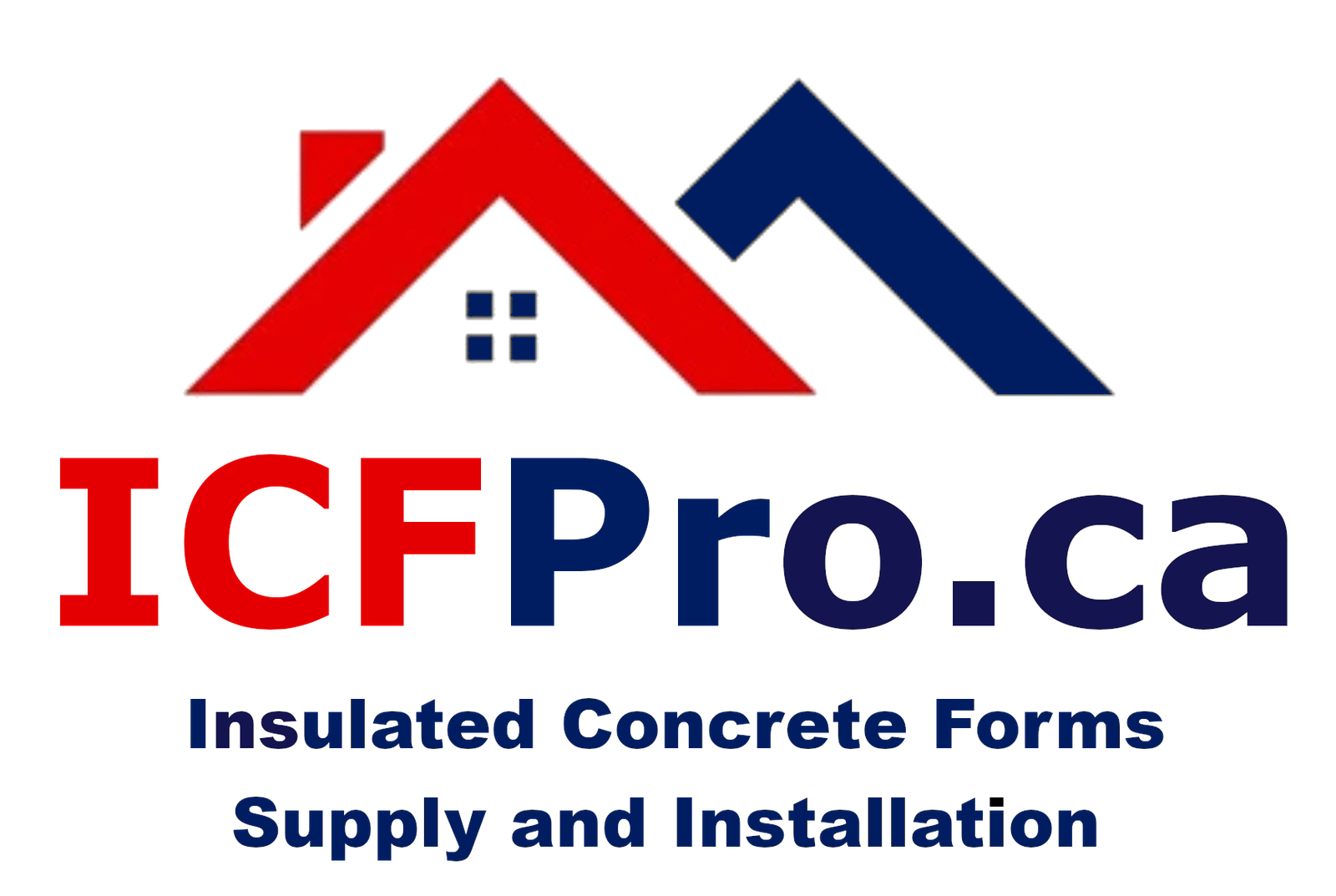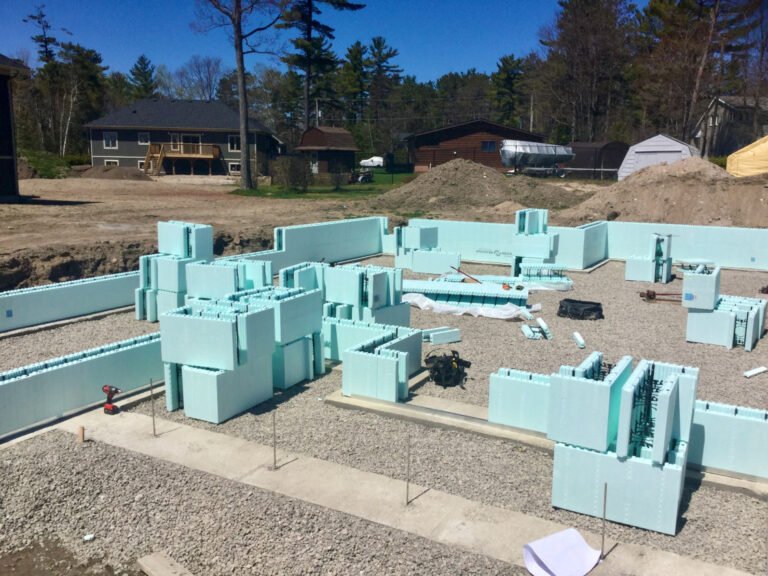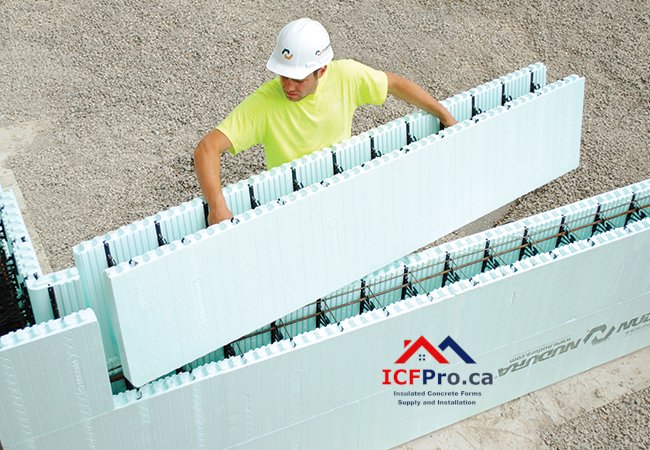ICFPro.ca is a division of ICFhome.ca - Phone 1 866 868-6606 - Direct Line 1 705 533-1633 - Email: info@icfhome.ca
ICF vs Traditional Construction: Why More Homeowners Are Making the Switch

Imagine living in a home that’s not just a shelter, but a fortress against the elements, a haven of energy efficiency, and a testament to modern construction innovation. This isn’t a futuristic dream—it’s the reality for homeowners who’ve made the switch to Insulated Concrete Form (ICF) construction. 🏠💪
As traditional stick-built homes face increasing challenges from extreme weather and rising energy costs, ICF technology is emerging as a game-changer in residential construction. But what exactly is ICF, and why are more homeowners opting for this alternative? From superior insulation to disaster resistance, the benefits of ICF are compelling enough to make even the most traditional builders take notice. 🌪️🌡️
In this post, we’ll dive deep into the world of ICF construction, comparing it with traditional methods across various aspects. We’ll explore its advantages, examine cost considerations, and look at the environmental impact. Whether you’re planning to build, renovate, or simply curious about the future of home construction, join us as we uncover why ICF might just be the smartest choice for your next home project.
Understanding ICF Construction

What is ICF (Insulated Concrete Forms)?
Insulated Concrete Forms (ICF) are an innovative construction method that combines the strength of reinforced concrete with the insulating properties of foam. This system consists of interlocking modular units that create a formwork for concrete walls. ICF has gained popularity among homeowners due to its superior durability and energy efficiency compared to traditional construction methods.
Key components of ICF systems
ICF systems comprise several essential components:
- Foam blocks or panels
- Reinforcing steel (rebar)
- Concrete
- Plastic or metal ties
| Component | Function |
|---|---|
| Foam blocks | Provide insulation and form the wall structure |
| Reinforcing steel | Adds strength and stability to the concrete |
| Concrete | Forms the core of the wall, providing structural integrity |
| Ties | Connect the foam panels and hold them in place during concrete pouring |
How ICF construction works
The ICF construction process involves the following steps:
- Stacking and interlocking foam blocks
- Installing reinforcing steel
- Pouring concrete into the forms
- Allowing concrete to cure
- Removing bracing and finishing interior and exterior surfaces
ICF construction offers several advantages over traditional methods, including:
- Increased energy efficiency
- Enhanced durability and strength
- Improved sound insulation
- Reduced construction time
As we explore the advantages of ICF over traditional construction in the next section, you’ll gain a deeper understanding of why more homeowners are making the switch to this innovative building technique.
Advantages of ICF over Traditional Construction

Superior energy efficiency
ICF construction offers remarkable energy efficiency compared to traditional building methods. The continuous insulation provided by ICF walls significantly reduces heat transfer, resulting in lower energy consumption and utility costs.
- Up to 60% reduction in energy bills
- Maintains consistent indoor temperature
- Eliminates thermal bridging common in traditional construction
Enhanced durability and strength
ICF structures boast exceptional durability and strength, outperforming traditional wood-frame or concrete block construction.
| Feature | ICF | Traditional |
|---|---|---|
| Compressive strength | 4,000+ PSI | 2,500-3,000 PSI |
| Wind resistance | Up to 250 mph | 100-150 mph |
| Lifespan | 100+ years | 30-50 years |
Improved sound insulation
The dense concrete core and insulating foam layers of ICF walls provide superior sound insulation, creating a quieter indoor environment.
- Reduces external noise by up to 50 decibels
- Ideal for urban areas or near busy roads
- Enhances privacy between rooms
Faster construction time
ICF construction can significantly reduce build times compared to traditional methods:
- Simplified assembly process
- Fewer separate components
- Simultaneous installation of insulation, structure, and vapor barrier
Disaster resistance
ICF buildings offer unparalleled protection against various natural disasters:
- Fire resistance: Up to 4-hour fire rating
- Earthquake resilience: Reinforced concrete core withstands seismic activity
- Flood resistance: Non-organic materials resist water damage and mold growth
With these advantages, it’s clear why more homeowners are choosing ICF over traditional construction methods. However, the decision to switch also involves considering the cost implications, which we’ll explore in the next section.
Cost Considerations

A. Initial investment comparison
When comparing ICF to traditional construction, it’s important to consider the upfront costs:
| Cost Factor | ICF Construction | Traditional Construction |
|---|---|---|
| Materials | Higher | Lower |
| Labor | Similar | Similar |
| Building Time | Shorter | Longer |
| Equipment | Specialized | Standard |
While ICF materials are generally more expensive, the reduced building time can offset some of these costs. The specialized equipment needed for ICF construction may also contribute to a higher initial investment.
B. Long-term energy savings
ICF construction offers significant long-term energy savings:
- Up to 70% reduction in heating and cooling costs
- Consistent indoor temperature
- Reduced HVAC system size and usage
These savings can quickly recoup the higher initial investment, making ICF a cost-effective choice over time.
C. Reduced maintenance expenses
ICF structures require less maintenance due to their durability:
- Resistance to mold, rot, and pests
- No need for frequent repainting or repairs
- Longer lifespan compared to traditional construction
This durability translates to lower maintenance costs throughout the life of the building.
D. Potential insurance benefits
Many insurance companies offer discounts for ICF homes due to their superior resistance to natural disasters:
- Lower premiums for wind and fire insurance
- Increased safety during extreme weather events
- Reduced risk of structural damage
These insurance benefits can further offset the initial costs of ICF construction. With these factors in mind, let’s explore how ICF construction impacts the environment and sustainability.
Environmental Impact

Reduced carbon footprint
ICF construction significantly reduces a home’s carbon footprint compared to traditional methods. The superior insulation provided by ICF walls results in lower energy consumption for heating and cooling, leading to decreased greenhouse gas emissions over the building’s lifetime.
| Aspect | ICF Construction | Traditional Construction |
|---|---|---|
| Energy Efficiency | Up to 70% reduction in energy use | Standard energy consumption |
| CO2 Emissions | Significantly lower | Higher due to increased energy needs |
| Lifespan | 100+ years | 30-50 years on average |
The longer lifespan of ICF structures also contributes to reduced environmental impact, as fewer resources are needed for rebuilding or major renovations.
Sustainable building materials
ICF construction utilizes eco-friendly materials that contribute to sustainability:
- Concrete: Made from abundant natural resources
- Expanded Polystyrene (EPS): Recyclable and produced with minimal waste
- Steel reinforcement: Often includes recycled content
These materials require less frequent replacement, further reducing the environmental impact over time.
Improved indoor air quality
ICF homes offer superior indoor air quality due to:
- Airtight construction that minimizes dust and allergen infiltration
- Resistance to mold growth, thanks to the inorganic nature of concrete
- Reduced off-gassing from building materials
This improved air quality not only benefits the environment but also contributes to better health outcomes for occupants. As we explore the next section on design flexibility and aesthetics, you’ll see how ICF construction doesn’t compromise on style while delivering these environmental benefits.
Design Flexibility and Aesthetics

Versatile architectural possibilities
ICF construction offers homeowners remarkable design flexibility, allowing for a wide range of architectural styles. From sleek modern designs to traditional colonial homes, ICF can accommodate diverse aesthetic preferences. The moldable nature of ICF blocks enables the creation of unique shapes, curves, and angles that might be challenging or costly with traditional construction methods.
- Architectural styles possible with ICF:
- Contemporary
- Mediterranean
- Craftsman
- Victorian
- Mid-century modern
Compatibility with various exterior finishes
One of the significant advantages of ICF construction is its compatibility with numerous exterior finishes. This versatility allows homeowners to achieve their desired look without compromising on the structural benefits of ICF.
| Exterior Finish | Compatibility with ICF |
|---|---|
| Brick | Excellent |
| Stone veneer | Very good |
| Stucco | Ideal |
| Siding | Compatible |
| EIFS | Highly suitable |
Interior design advantages
ICF construction not only offers exterior design flexibility but also provides significant interior design benefits. The thick walls created by ICF blocks allow for deep window sills, creating attractive focal points and additional space for décor. The superior insulation properties of ICF walls also contribute to a quieter interior environment, enhancing the overall ambiance of the home.
- Interior design benefits of ICF:
- Deeper window sills for added character
- Improved soundproofing for a serene living space
- Consistent indoor temperature for comfort
- Potential for unique built-in features
With these design advantages, it’s no wonder that more homeowners are considering ICF construction for their dream homes. Next, we’ll explore real-life experiences of homeowners who have made the switch to ICF construction.
Homeowner Experiences

Comfort and livability improvements
Homeowners who have made the switch to ICF construction consistently report significant improvements in their day-to-day living experience. The superior insulation properties of ICF walls create a more stable indoor environment, reducing temperature fluctuations and eliminating drafts. This results in a noticeably more comfortable living space throughout the year.
Reduced utility bills
One of the most tangible benefits of ICF construction is the dramatic reduction in energy costs. Many homeowners report savings of up to 50% on their heating and cooling bills compared to traditional construction methods. This table illustrates the potential annual savings:
| Home Size | Traditional Construction | ICF Construction | Annual Savings |
|---|---|---|---|
| 1,500 sq ft | $2,400 | $1,200 | $1,200 |
| 2,500 sq ft | $3,600 | $1,800 | $1,800 |
| 3,500 sq ft | $4,800 | $2,400 | $2,400 |
Increased property value
The durability and energy efficiency of ICF homes translate into higher property values. Real estate professionals report that ICF homes often command a premium in the market due to their:
- Lower maintenance requirements
- Enhanced energy efficiency
- Superior soundproofing
- Improved indoor air quality
Peace of mind in extreme weather
Perhaps the most compelling aspect of ICF homes is the sense of security they provide during severe weather events. Homeowners in hurricane-prone areas or regions susceptible to tornadoes praise the resilience of their ICF structures. Many have shared stories of their homes withstanding extreme conditions while neighboring properties suffered significant damage.
With these experiences in mind, it’s clear why more homeowners are choosing ICF construction. Next, we’ll address some common misconceptions about this building method to provide a comprehensive understanding of its benefits and limitations.
Overcoming Common Misconceptions

Addressing concerns about cost
Many homeowners hesitate to adopt ICF construction due to perceived higher upfront costs. However, it’s crucial to consider the long-term savings:
| Cost Factor | ICF Construction | Traditional Construction |
|---|---|---|
| Initial Cost | Higher | Lower |
| Energy Savings | Up to 70% annually | Standard |
| Maintenance | Minimal | Regular |
| Resale Value | Higher | Standard |
While ICF may have a higher initial investment, the energy efficiency and durability lead to significant savings over time, often offsetting the initial cost difference within 5-7 years.
Dispelling myths about limitations
Common misconceptions about ICF construction include:
- Limited design options
- Difficulty in renovations
- Incompatibility with traditional finishes
In reality, ICF structures offer:
- Versatile design possibilities
- Easy modifications for future renovations
- Compatibility with various exterior and interior finishes
Explaining adaptability to different climates
ICF construction excels in various climates due to its superior insulation properties:
- Hot climates: Reduces cooling costs
- Cold climates: Minimizes heat loss
- Humid areas: Resists moisture penetration
- Coastal regions: Withstands high winds and saltwater exposure
This adaptability makes ICF an excellent choice for homeowners across diverse geographical locations, contributing to its growing popularity over traditional construction methods.

The shift towards ICF construction represents a significant evolution in home building practices. As we’ve explored, ICF offers numerous advantages over traditional construction methods, including superior energy efficiency, durability, and sound insulation. While initial costs may be higher, the long-term savings on energy bills and maintenance make ICF a cost-effective choice for many homeowners. Moreover, its reduced environmental impact and design flexibility further enhance its appeal.
As more homeowners become aware of ICF’s benefits and dispel common misconceptions, we’re likely to see a continued rise in its adoption. Whether you’re building a new home or considering a major renovation, ICF construction is worth exploring. It’s not just about building a house; it’s about creating a more comfortable, sustainable, and resilient home for the future.



